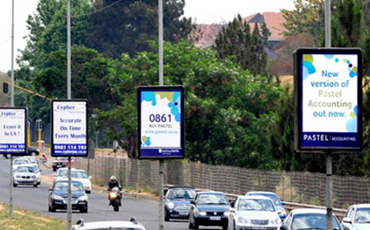Indoor LED display refers to medium and large LED display equipment used indoors, such as conference rooms, churches, supermarkets, hotels, bank halls, etc.
These devices can all be seen. The area of indoor LED display screens mostly ranges from 3 square meters to more than ten square meters.
Their luminous point density is higher, but they are slightly less waterproof and brighter than outdoor LED displays.
Outdoor LED screens refer to LED screens used for outdoor advertising displays, most of which are installed on pillars or on the upper floors of buildings. Its products have high brightness, dozens of times higher than indoor LED displays.


If the indoor LED display is placed outdoors, it will be like placing a TV outdoors. The brightness is not enough and the thin screen content cannot be seen clearly.
Therefore, outdoor LED displays must use ultra-high-brightness LEDs, and in order to further improve the brightness and increase the viewing distance, multiple ultra-high-brightness LEDs are often packaged in one pixel.
At the same time, outdoor LED displays must be resistant to (rain) water, direct sunlight, dust, high temperature, wind, lightning strikes, etc., while indoor LED displays do not need to consider these issues.
Select according to LED display specifications and sizes
There are many sizes of LED display screens, such as P0.9, P1.2, P1.5, P1.8, P2.5, P3, P4 and other indoor models, as well as P5, P6, P8, P10 and other outdoor models.
Different sizes have different spacing and display effects, so the choice should be made based on the situation.
Select according to LED display length-to-width ratio
The aspect ratio of the LED display screen will directly affect the viewing effect, so the aspect ratio of the LED display screen is also an important factor to consider in model selection.
Generally, graphic and text screens do not have a fixed ratio, which is mainly determined based on the display content. The more common aspect ratios of video screens are generally 4:3, 16:9, etc.
Select according to LED display color
LED display screens can be divided into monochrome screens, dual-color screens or full-color screens. Among them, LED monochrome displays are luminous screens with only one color, and the display effect is not very good; LED dual-color screens are generally composed of 2 red + green LEDs.
It is composed of diodes and can present subtitles, pictures, etc.; the LED full-color display screen is rich in color and can present various pictures, videos, subtitles, etc.
Currently, the most commonly used ones are LED two-color display screens and LED full-color displays.

Various models of LED display screens are available. According to the requirements of different usage scenarios such as the customer’s display environment, LED series products with different spacings ranging from P0.9 to P4 indoors and P5 to 10 outdoor can be selected.
At the same time, it has high-definition image quality, using high-quality small-spacing LED lamp beads to emit light, with high contrast, full and rich colors, and delicate and lifelike colors.
It adopts highly integrated, high-grayscale and high-refresh display technology.
The 16-bit processing system reaches 65536 levels of grayscale, which can form 281 trillion colors; the high-speed refresh frequency can reach over 3840 Hz, which can fully adapt to the needs of high-speed cameras and high-definition TV broadcasts.
The LED display screen has high-quality modules and adopts a modular display unit module design, which can be seamlessly spliced in any direction, any size, and any shape; it is also waterproof and dustproof, easy to disassemble and install, and also convenient for maintenance.
Using RGB three-primary color imaging technology, the color gamut is wide and reaches broadcast-level standards.
After single-point brightness and chromaticity correction, the color temperature of the screen can be adjusted in a range of 3000-12000K.

“How to choose the model of LED display screen which has clear effect”
Here we would like to remind users who are planning to buy LED displays that the display with denser points does not necessarily have the best cost performance and is most suitable for your use.
You can consider it based on the size of the area and viewing distance requirements. LEGIDATECH‘s professional sales staff will give you appropriate suggestions for your actual situation for you to choose outdoor LED display, LED display, LED electronic screen, indoor full-color display.Indoor full-color display.
Here are some examples of indoor LED display models:
P0.8, P0.9, P1.0, P1.25, P1.5, P1.667, P1.875, P1.9 are indoor small-pitch LED display models.
Commonly used in indoor places of governments, agencies, and institutions (such as video conferencing, monitoring centers, command centers, studios, etc.).
The requirements for close viewing are very clear. Small-pitch screens have high pixels and clear displays, making it easier to achieve 4k effects, but the cost is relatively high.

P2, P2.5, and P3 are indoor high-definition LED display models, commonly used in conference rooms, lecture halls, exhibition halls, churches, hotels, etc.
It is suitable for a viewing distance of 3 meters and the area is suitable for an area of more than 6 square meters.
P4 and P5 are often used in hotel banquet halls and restaurant stage background LED screens. They can be used as temporary stage setups and LED stage screens for performances and events.
In order to facilitate portability and transportation, they can be freely disassembled and assembled into boxes. According to the site environment, they can be spliced together in any size.
Generally, there are iron led cabinets, aluminum led cabinets, and also equipped with flight cases for packaging and transportation.





